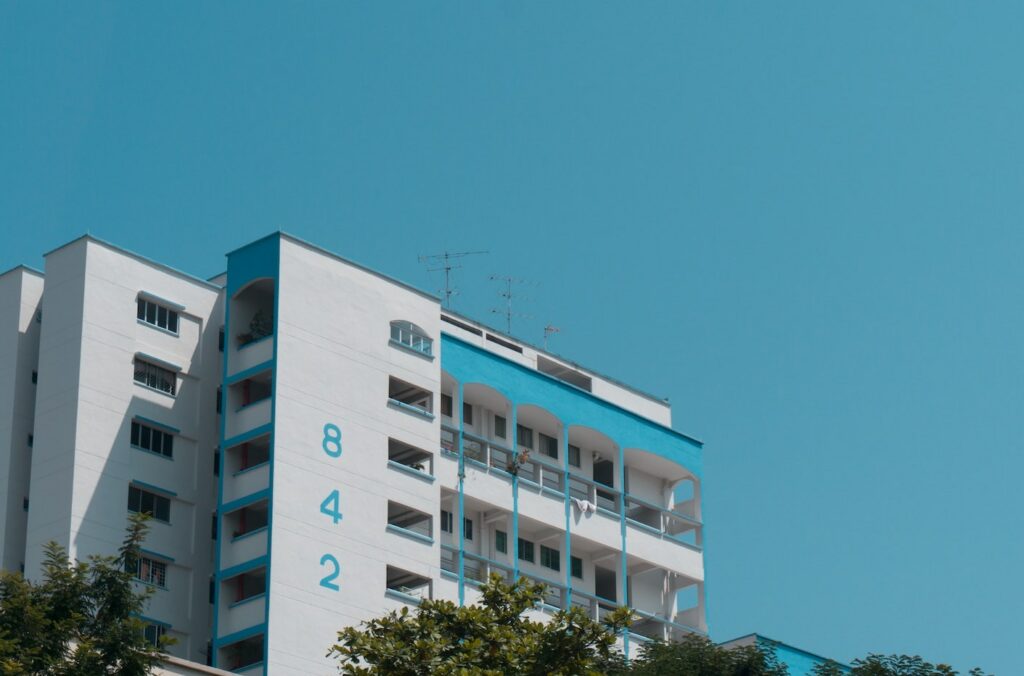
What would you do with an extra $1,000 in passive income each month? Would you treat your family to dinner at Nobu? Save up for a Christmas ski vacation? Put it towards a down payment for a Tesla? The possibilities are endless!
Generating $1,000 in monthly passive income may seem far-fetched in Singapore, but we’re here to tell you it’s actually within reach for many people.
Here are some ways to build passive income in Singapore.
Table of Contents
- Open a High-Yield Savings Account (HYSA)
- Earn Interest from Fixed Deposits
- Create a Bond Ladder
- Generate Income from Dividend Stocks
- Invest in Real Estate Investment Trusts (REITS)
- How to Create a $1,000/Month Dividend Income Portfolio
- Harnessing the Power of Compound Interest to Generate Passive Income
- Make $1,000 a Month in Passive Income in Singapore
Open a High-Yield Savings Account (HYSA)
Signing up for a HYSA is a great set-it-and-forget-it approach to generating passive income. While a HYSA may not bring about as high a return as other passive income ideas, it provides a much higher yield compared to traditional bank accounts.
You also don’t need a ton of money upfront to get started, and setting up an account can be done easily online with a few clicks, making it one of the simplest ways to make extra cash.
Earn Interest from Fixed Deposits
Putting your money in fixed deposits is a relatively low-risk way to make passive income. Fixed deposits offer a guaranteed return on your investment, and all you need to do is to put in an amount to your preferred account.
Fixed deposits may not be for everyone since you need a lump sum of cash to sign up for an account. People who require more liquidity may also want to note that most banks impose an early withdrawal penalty.
If you don’t have the required funds to meet the minimum deposit amount, a cash management product like Syfe’s Cash+ Guaranteed might be a better alternative. Cash+ Guaranteed doesn’t impose a minimum deposit amount, making it great for people who don’t have a lot of cash on hand but would still like to optimise their savings to earn more passive income.
Create a Bond Ladder
Bond laddering is a popular investment strategy that involves the construction of a portfolio containing bonds with a series of maturity dates to create consistent cash flow.
Here’s an example:
You’re an investor who purchased bonds with different maturities: 1 year, 3 years, and 5 years.
As the bond matures, you can reinvest the principal of the recently matured bond into a new bond with a longer duration, repeating this process for each newly matured bond to create a bond ladder.
Apart from being a great way to generate passive income, a bond ladder decreases reinvestment risk, which happens when you buy a new bond when interest rates are unfavourable.
Bonds, however, come with their own set of concerns; corporate bonds, for example, are vulnerable to default risk—a problem that occurs when companies are unable to pay principal or interest payments.
Many investors turn to bond ETFs because of these risks, which provide a diversified portfolio of multiple bonds, removing the risk of a single bond hurting your returns.
If you’re looking to invest in bonds, why not consider Syfe’s Income+ portfolio? Income+ provides investors like you access to best-in-class bonds all in one portfolio while receiving monthly dividend payouts. It’s a great option for people looking for a diversified bond portfolio and an easy way to invest.
Generate Income from Dividend Stocks
Earning passive income through dividend investing is an effortless way for Singaporeans to supplement their paychecks.
Dividend investing is popular in Singapore because dividend payments by Singapore-based companies are not subjected to withholding tax. For shareholders, this means that any dividend income earned is tax exempted, and for this reason, blue chip stocks are well-liked among Singaporean investors.
Here are some things to consider when deciding on what dividend stocks to invest in:
- History of consistent dividends
- Track record of consistent earnings growth
- Healthy cash flow
- Sustainable payout ratio and dividend yield
- Mid-to-large cap stocks issued by well-established companies
Invest in Real Estate Investment Trusts (REITS)
Before we go further, let’s look at why Singapore REITs are an attractive choice for dividend investing.
Firstly, REITs are real estate investments that generate rental income from properties such as shopping malls, office buildings, hotels, warehouses and more.
Given that Singapore REITs offer relatively high dividend yields, they’re a popular choice among many Singaporean investors. They’re required to distribute 90% of this income as dividends to investors, and many Singapore REITs have averaged dividend yields of 5% to 6%.
In other words, if you invest $10,000 into a REIT with a dividend yield of 5%, you’ll receive $500 in dividends for that year. This is more attractive compared to other investments such as Singapore stocks (Straits Times Index) or government bonds.
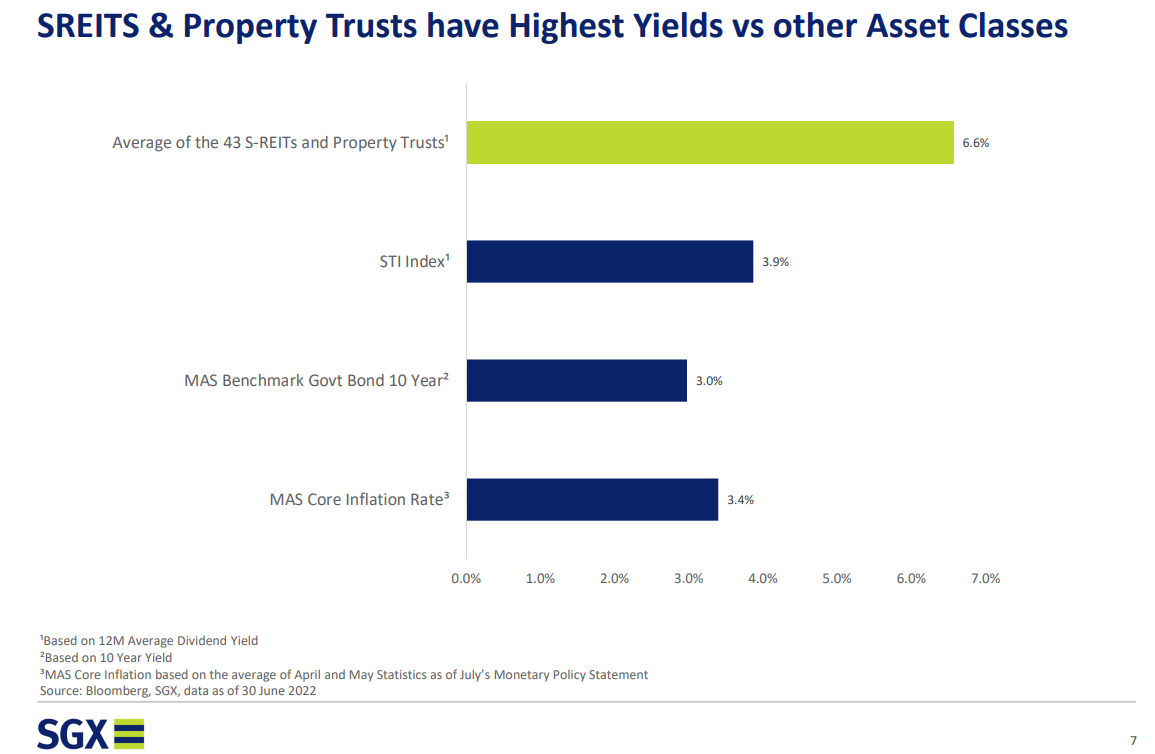
How to Create a $1,000/Month Dividend Income Portfolio
A dividend income portfolio is simply a portfolio consisting of dividend-paying investments.
If your target is $1,000 in passive income each month, your dividend portfolio will need to generate $12,000 in dividend income each year. Let’s take the average dividend yield to be 5% every year. Your portfolio size will then need to be $240,000 (5% x $240,000 = $12,000).
But don’t let this seemingly high figure put you off! You don’t have to invest a lump sum of $240,000 all at once. Instead, you can start with a smaller initial investment and follow up with monthly contributions.
Here’s a sample plan.
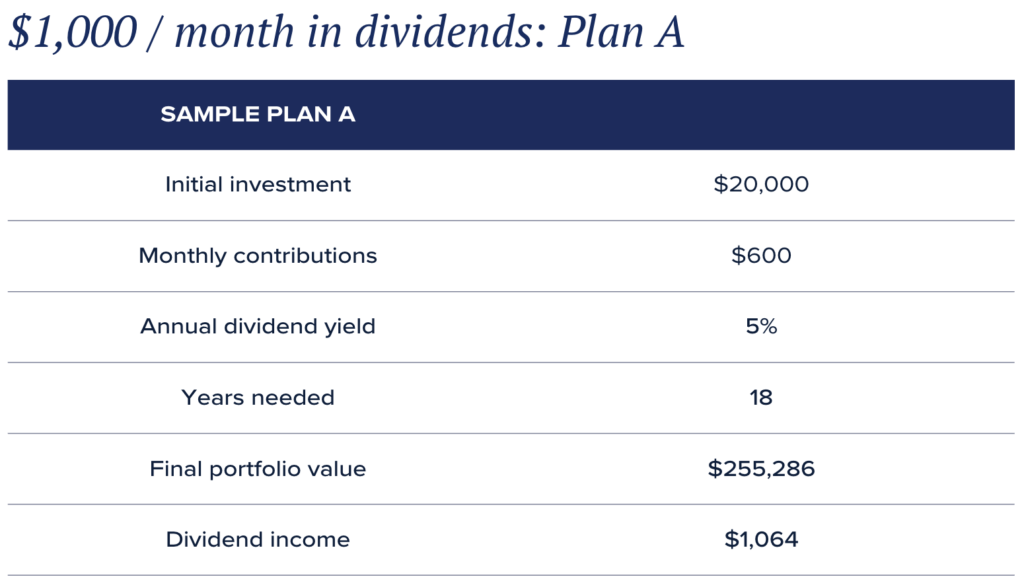
the stated time period. Figures derived from an online investment calculator here.
In 18 years, your portfolio value will grow to around $255,286, assuming all dividends were reinvested to boost the compounding effect. If we assume a constant 5% annual dividend yield, this provides you with $1,064 in monthly passive income. At this point, you can stop your monthly contributions and begin withdrawing your dividends to spend!
A More Optimistic Outlook
Assuming a 5% dividend yield with no capital appreciation is more of a base-case scenario. On average, if we take dividend yield to be 5%, and capital appreciation to be 2% each year, the long-term total return for a stock could approach 7% each year.
Based on this scenario, it would take 15 years to build a portfolio value of $241,843. At a 5% dividend yield, this would provide you with $1,008 per month in dividend income.
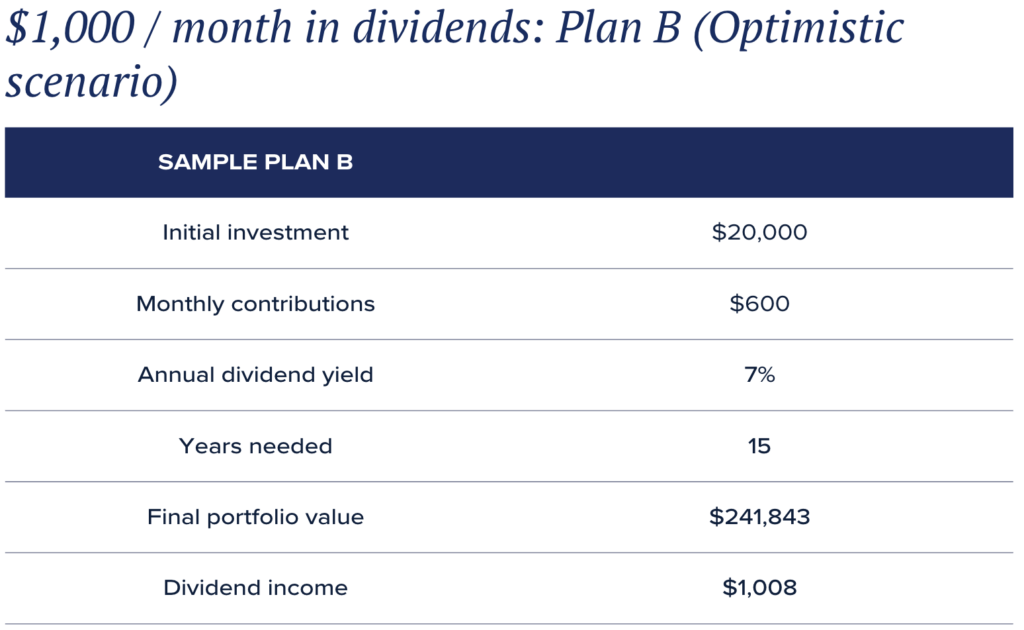
Figures derived from an online investment calculator here.
How to Earn Passive Income Sooner
If you can invest more, you can achieve your passive income goal considerably sooner by increasing your initial investment and / or monthly contributions.
Here’s an example that shaves off 5 years from the sample plan earlier. In just 10 years, your portfolio could grow to $252,304. At a 5% dividend yield, this would provide you with $1,051 per month in dividend income.
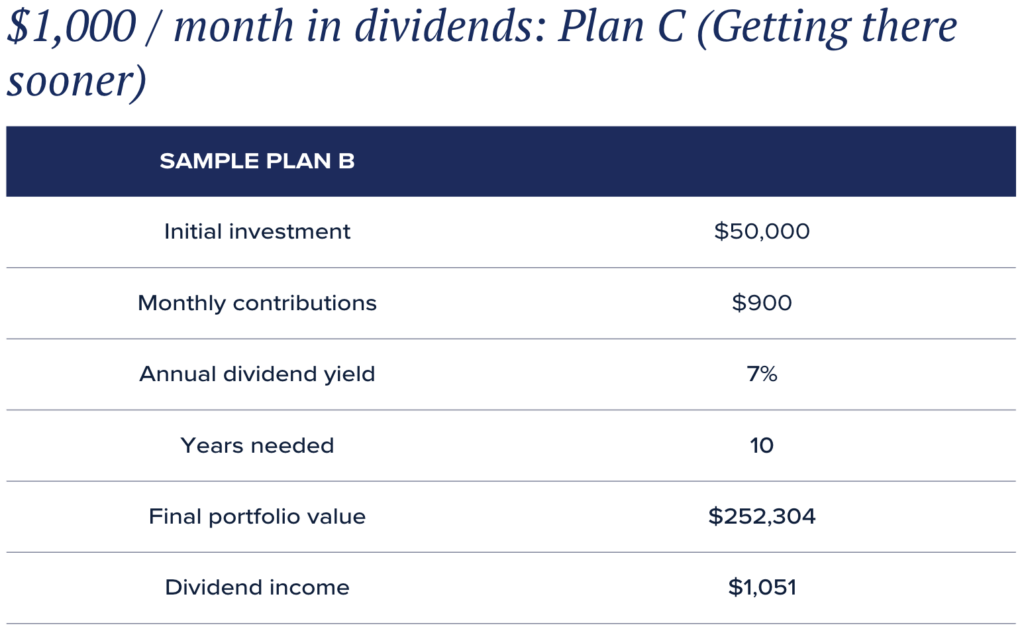
Figures derived from an online investment calculator here.
That said, investing is a marathon, not a sprint. What’s more important is finding an investment plan you can commit to for the long haul. This will enable you to comfortably maintain your regular investments, which is half the battle won!
Best REITs in Singapore for Dividend Investing
Office REITs and retail REITs historically have higher average dividend yields. In 2022, rents in Singapore’s office and retail sector have rebounded on robust demand and the easing of pandemic restrictions.
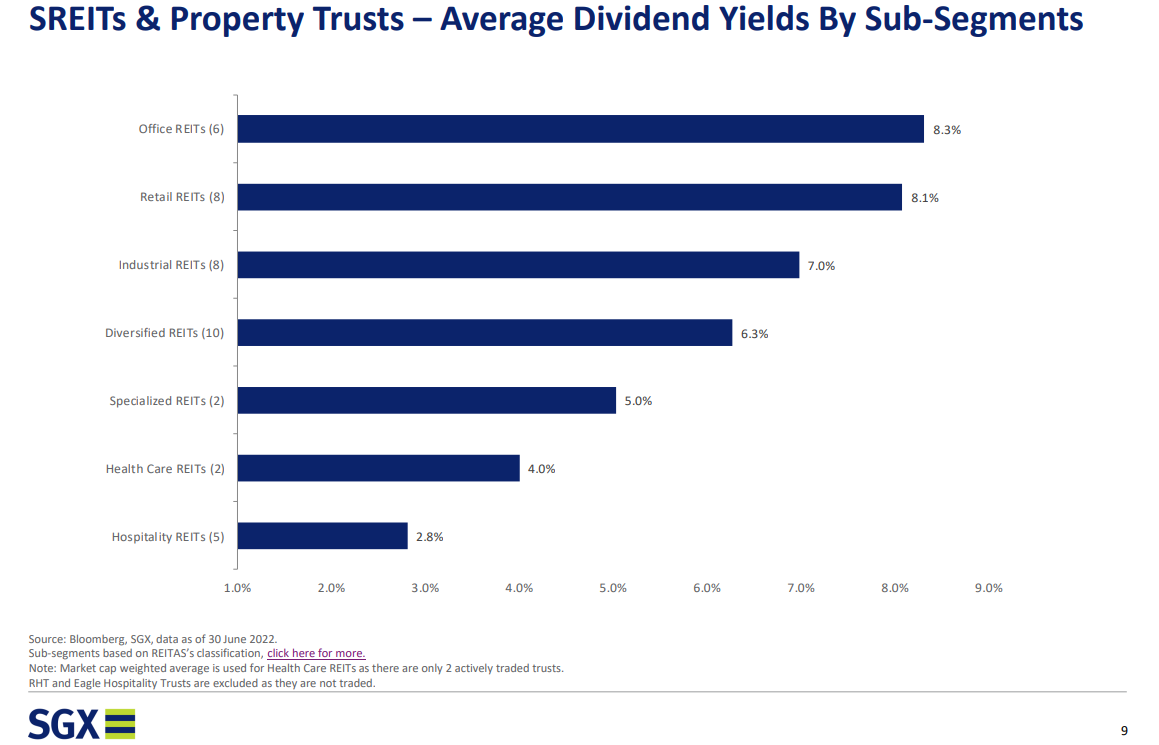
However, picking REITs based only on the highest dividend yield may not necessarily be the best course of action. As the saying goes, don’t put all your eggs in one basket.
For instance, office and retail REITs came under pressure during the COVID-19 pandemic. A portfolio exposed to just these two sectors would have been affected by the work-from-home mandates and various social restrictions.
A better approach would be to invest in a diversified REIT portfolio spanning all property sectors like retail, industrial, data centre, office, hospitality, and healthcare. Should any one sector face industry headwinds, your exposure to other sectors can help cushion the impact.
Consider Syfe REIT+ for example. The portfolio holds 20 of Singapore’s largest REITs including:
- Ascendas REIT (SGX:A17U)
- CapitaLand Integrated Commercial Trust (SGX: C38U)
- Mapletree Commercial Trust (SGX: N2IU)
- Keppel DC REIT (SGX: AJBU)
- Parkway Life REIT (SGX: C2PU)
- Ascott Residence Trust (SGX:HMN)
This broad diversification helps REIT+ weather market ups and downs better. In 2023, the estimated dividend yield for Syfe REIT is 5.67%.
Harnessing the Power of Compound Interest to Generate Passive Income
Remember how the sample plans above involved your dividends being reinvested? That’s because reinvesting your dividends is the best way to benefit from compound interest.
Let’s illustrate this with an example. Assume that you invest $10,000 today in a stock that averages 5% dividend yield each year.
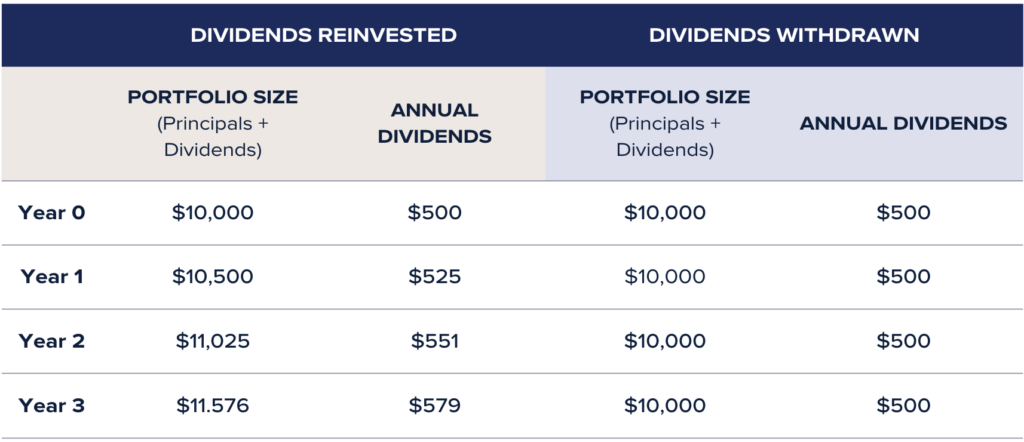
Notice how your annual dividends earned increase each year if you reinvest them? That’s because your reinvested dividends are used to buy more shares of the REIT, thus providing you with even more dividends.
In essence, compound interest is a virtuous cycle where you not only earn returns on your principal sum, but also earn additional returns on your returns.
Contrast that with the scenario where you don’t reinvest your dividends. You’d miss out on the benefits of compound interest and only receive $500 in dividends each year.
The takeaway is that the power of compound interest can also help your portfolio grow more quickly. Whichever investment plan you choose, reinvesting your dividends is key to achieving your target monthly passive income.
Make $1,000 a Month in Passive Income in Singapore
It will take some patience and discipline to grow your passive income streams and invest consistently. Rome wasn’t built in a day after all. But if passive income is what you seek, the payoff can be worth it.
Listen to this episode on Spotify, Apple Podcasts, or Google Podcasts.






You must be logged in to post a comment.